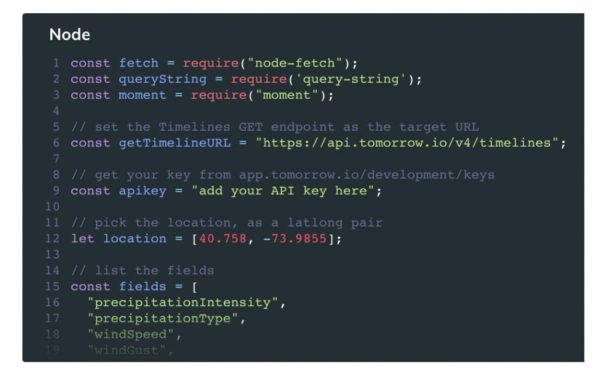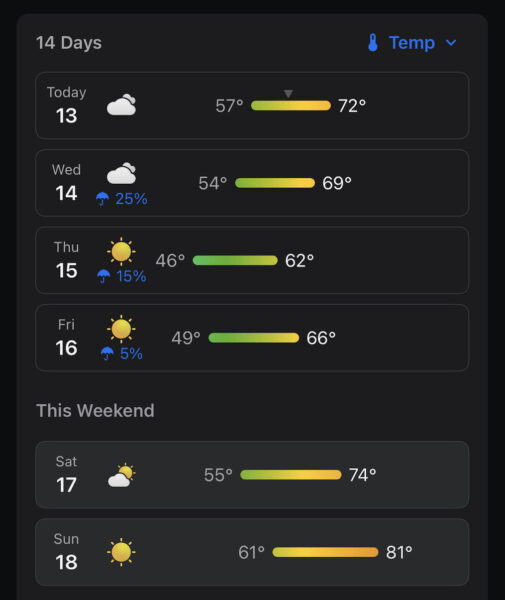Thanks to technological advancements and a better understanding of weather patterns, weather prediction has become more accessible than ever. Accurate, real-time, and historical weather data can be a game-changer for developers and businesses. That’s where a weather REST API comes in handy, bringing the power of weather forecasting to your fingertips. In this blog, we’ll explore the benefits of using a REST API and show you how to start with Tomorrow.io’s weather API.
What is a Weather REST API?
As weather becomes increasingly volatile and costly, accurate everyday weather information is crucial for smooth day-to-day operations. Fortunately, weather APIs have made it easier than ever to integrate real-time weather data into various applications and services, providing users with instant access to critical weather information.
A Weather REST API is a service that follows the principles of Representational State Transfer (REST), which allow applications to request and exchange weather-related data over HTTP efficiently and standardized. In addition, a Weather REST API not only retrieves data but also allows for manipulation of the data to fit the needs of the application or service. Essentially, a Weather REST API acts as a conduit, retrieving weather information from a server and delivering it seamlessly to the client application.
What are the Benefits of Using a Weather REST API?
Weather is a crucial element in many industries, from transportation to agriculture, tourism, and emergency services. Accurate weather data can greatly improve decision-making processes and lead to more efficient operations. This is where a Weather REST API comes in handy.
A Weather REST API allows developers to integrate weather data into their applications seamlessly. Rather than collecting and processing the data themselves, developers can simply make requests to these APIs, receiving comprehensive responses on weather conditions, forecasts, and more. This saves time and also ensures that the data is accurate and up-to-date.
There are many benefits to using this API. It allows you to incorporate real-time, accurate weather data into your applications, improving their functionality and user experience. This can include providing current weather conditions and forecasting future trends.
A RESTful API is stateless, meaning that each request from the client to the server must contain all the necessary information to understand and fulfill the request. This leads to greater scalability and flexibility because the server doesn’t need to store any information about the client between requests.
Using a REST API can improve efficiency and productivity. Since REST utilizes standard HTTP methods, developers can use standard tools to interact with the API, reducing the learning curve and speeding up development time.
Getting Started with a Weather REST API
Starting with a Weather REST API might initially seem intimidating, but it can be straightforward with the right approach and resources. We’ll focus on getting started with Tomorrow.io’s Weather API for this guide.
Using Tomorrow.io’s API Key
To access the services provided by Tomorrow.io’s Weather API, you’ll need an API key. This key is a unique identifier that authenticates the user or application making a request. When you send a request to the Weather API, the key is used to verify your access privileges and track the usage of the service.
Accessing Your API Key
To access your Tomorrow.io weather API key, sign up for an account at Tomorrow.io.
Once you’ve registered with Tomorrow.io and chosen the appropriate service tier for your needs, you can access your unique API key.
Log in to your account and navigate to your dashboard.
Here, you’ll find your API key. Remember, this key is sensitive information and should be kept confidential. Now that you have your key, you’re ready to start requesting the Weather API, opening a world of possibilities for integrating weather data into your applications.
In the next section, we’ll discuss how to work with a weather REST API, making requests, parsing responses, and using multiple APIs.
Working With a Weather REST API
After successfully obtaining your API key, the next step is working with the Weather REST API. The beauty of using a REST API lies in its versatility, allowing you to access historical data, make data requests, and parse responses to suit your application’s requirements. This section will walk you through these processes using Tomorrow.io’s Weather API.
Accessing Historical Data and Forecasts
One of the compelling features of Tomorrow.io’s Weather REST API is its ability to provide not only real-time weather data but also historical data and future forecasts. This data can be critical for various sectors, including agriculture, event planning, travel, and more.
To access the data you need, you must include specific endpoints in your API request. These endpoints depend on the type of data you want, such as using the /historical/ endpoint for past weather data or the/forecast/ endpoint for future weather predictions.
Making Requests for Data from Your Application Programming Interface (API)
Sending a request to Tomorrow.io’s Weather API is as simple as making an HTTP request from your application. These requests include your unique API key for authentication and may contain other parameters depending on the data you’re seeking.
Typically, a GET request to retrieve weather data might look something like this:
GET https://api.tomorrow.io/v4/timelines?location=42.3601,-71.0589×teps=1h&fields=temperature×teps=1h&apikey=YOUR_API_KEYIn this example, we’re requesting hourly temperature data for a specific location (latitude 42.3601, longitude -71.0589).
Parsing Responses from the API Server
After sending a request, the API server will respond with data in a structured format, usually JSON (JavaScript Object Notation). Parsing, or interpreting, this response involves extracting the required data from the JSON object for use in your application. Various programming languages offer different methods for parsing JSON data, so choose the one that best suits your application’s needs.
Utilizing Multiple APIs for Different Parameters
Tomorrow.io’s Weather API is incredibly versatile, providing a wealth of data beyond just temperature readings. By utilizing different API endpoints, you can access a plethora of weather parameters such as precipitation, wind speed, humidity, air quality, and many more.
Each parameter can be requested by specifying it in your API call. This means you can tailor your requests to the exact needs of your application, whether you require a broad overview of the weather or specific details for a particular aspect.
Through the process of accessing historical data and forecasts, making requests, parsing responses, and utilizing multiple APIs, you can harness the full power of Tomorrow.io’s Weather REST API. In the next section, we’ll delve into the best practices for integrating this API into your applications seamlessly.
Best Practices for Weather REST API Integration
Integrated weather data is a crucial component for many businesses and organizations, from aviation and construction companies to logistics and sports entertainment.. Weather forecasts can help them make informed decisions about scheduling, logistics, and resource allocation. However, integrating weather data can be a complex process, particularly when using REST APIs. By following some best practices for weather REST API integration, businesses and organizations can make the most out of the available resources to deliver reliable weather data to their users. Here are some key considerations to ensure successful integration.
Rate Limiting and Caching
In a fast-paced digital world, where data is being transferred between multiple devices and systems within milliseconds, rate limiting and caching have become essential tools for many businesses. Rate limiting controls how often a user can access an application programming interface (API), while caching stores frequently requested data temporarily, thus reducing the number of API requests needed.
Rate limiting can be used to prevent excessive calls to a weather API which can save costs and improve server performance. When the usage limit is reached, the rate-limiting mechanism can block any further requests for a set period. As such, it helps to prevent abuse or overload of the server and maintain data accuracy.
Caching, on the other hand, decreases server load and improves application performance by storing frequently used data in memory or on the disk. As more requests are sent for the same data, the data is retrieved from the cache instead of the server, which leads to a substantial reduction in time and resources needed to serve the requests. In the context of weather APIs, caching can significantly decrease the period between the data request and response.
Both rate-limiting and caching can significantly reduce the processing time and eliminate the possibility of overwhelming the server, resulting in better API performance with less downtime. Using a combination of rate limiting and caching can ensure that weather data is always available to those who need it, reducing the possibility of data loss and improving user experience.
Both rate-limiting and cashing are critical tools for businesses that rely on weather APIs to function efficiently. By regulating the number of requests made to the server and minimizing the load on the server with cached data, businesses can increase performance, reduce downtime, and lower costs. With the ever-increasing demand for real-time weather data, these mechanisms will continue to play a vital role in ensuring that weather data is available to everyone who needs it, without compromising on data accuracy, reliability, and overall user experience.
Error Handling and Retry Strategies
Developers using weather REST API services face a variety of challenges, ranging from predicting weather conditions to handling high volumes of requests. One critical aspect of managing these services is error handling. It’s crucial to have a mechanism in place to deal with errors that occur when weather data is requested. This can include server errors, network issues, or user input errors. A well-designed error-handling mechanism can improve the user experience and decrease the number of support requests.
Implementing a retry strategy is another tool in the developer’s toolbox when working with weather APIs. These services handle a vast amount of data, and sometimes errors occur due to network issues, server overload, or other factors outside of our control. This is where the retry strategy comes into play. If a request fails, it can be automatically retried after a set time interval, ensuring that the required data is eventually retrieved.
There are various retry strategies to choose from, including exponential backoff, which increases the wait time between each retry; fixed backoff, which maintains a constant time between retries; and jitter backoff, which adds random, fluctuating wait times to retries to alleviate server overload issues. Choosing the appropriate retry strategy for your application will depend on your specific use case, but by employing these strategies, developers can improve the reliability and uptime of their weather APIs.
As weather data is crucial to many industries, such as agriculture, transportation, and tourism, ensuring the accuracy of the data and reducing disruptions to the delivery of the data is paramount. By implementing a well-designed error-handling mechanism and retry strategy, developers can create more robust and efficient applications that rely on weather data APIs. Ultimately, this will improve user satisfaction and lead to better long-term business outcomes.
Optimizing API Calls
As APIs become an integral part of modern web development, it is essential to optimize API calls to improve performance and reduce overhead costs. In the context of weather APIs, optimizing API calls can significantly increase the accuracy and reliability of the data returned, leading to better-informed decision-making and enhanced user experiences.
One key way to optimize API calls is through caching. By storing frequently accessed data locally, developers can reduce the number of API calls required, thereby cutting down on the time and resources needed to retrieve data. This is especially beneficial for weather APIs, where many requests may be made for the same geographic areas. Caching can be implemented using client-side techniques, such as browser caching or local storage, or through server-side solutions like Redis or Memcached.
Another optimization technique is to utilize batch processing to reduce the number of individual API requests. With batch processing, multiple requests are grouped together, and a single request is sent to the API, returning all requested data in one response. This approach is particularly useful when requesting data from services that have limitations on the number of requests per day or per second. Batch processing can be achieved using methods such as GraphQL, REST API batch requests, or custom-designed batch processing solutions.
Finally, developers can optimize API calls by prioritizing the most critical data and reducing the amount of data requested. By focusing on essential data, developers can limit the amount of API calls made, reducing overhead and improving response times. Additionally, by using more targeted requests, developers can limit the amount of extraneous data returned, which can further improve performance.
In conclusion, optimizing API calls is crucial for improving the performance and reliability of weather APIs. By employing caching, batch processing, and targeted requests, developers can reduce overhead costs and enhance the overall user experience. The importance of API optimization will only continue to grow as APIs become even more critical to web development in the years to come.
Use Cases for Weather REST API
A weather REST API provides developers with a powerful and versatile tool for accessing real-time and historical weather data. From mobile applications to complex weather modeling systems, there is a wide range of use cases for Weather REST API that are essential for various industries.
By leveraging the capabilities of Weather REST API, developers can integrate accurate and reliable weather data into their applications, providing users with access to essential weather information to make informed decisions in their daily lives and for businesses to optimize their operations. Here are some use cases for Weather REST API.
Travel and Tourism
There’s no industry making a come back like the travel and tourism industry. Compared to the number of people traveling in 2020, things have been on the rise. With these numbers growing and with advances in technology, the way we travel has changed drastically in recent years.
Today, travelers can customize their own itineraries and access information about destinations with just a few clicks on their smartphones. From researching hotels and local restaurants to booking flights and excursions, everything can be done with the touch of a button. And most importantly, they can use the weather forecast as a determining factor.
For the travel and tourism industry, accurate and timely weather data is crucial. Whether it’s helping tourists plan their activities or assisting airlines in managing their flight schedules, a Weather REST API can play a critical role. Travel apps can integrate Tomorrow.io’s REST weather API to provide users with real-time weather updates and forecasts, helping them make informed decisions about their travel plans.
Agriculture and Farming
Agriculture and farming have been integral to human survival for thousands of years. It has also been a key sector in the global economy, providing livelihoods for millions of people and contributing to food security. As the world’s population continues to grow, agriculture and farming will only become more important in ensuring that people have access to sufficient and nutritious food.
In recent years, there has been a growing interest in sustainable agricultural practices. This involves using techniques that minimize negative environmental impacts while still maintaining production levels, all while staying educated on current weather conditions. With accurate weather data from Tomorrow.io farmers in remote areas of the world can leverage insights to inform their farming.
The agriculture sector can also significantly benefit from integrating a Weather REST API. Farmers can access historical weather data and future forecasts to make informed decisions about planting, irrigation, and harvesting. Moreover, this data can help manage risks related to weather, like droughts or floods, and aid in resource planning.
Outdoor Events
Outdoor events are loved around the world. From music festivals to sports tournaments, these gatherings offer a chance for people to come together and enjoy shared experiences. However, as we continue to grapple with the late effects of the COVID-19 pandemic, these events need to be informed with weather data and more.
Organizers of outdoor events such as music festivals, sports events, or community gatherings can utilize a Weather REST API to plan their activities. By integrating Tomorrow.io’s REST weather API, they can receive real-time updates and forecasts, helping them ensure the safety and comfort of their attendees and make necessary arrangements in case of adverse weather conditions.
Risk Assessment and Insurance
In our volatile world, risk management and insurance play an important role in keeping individuals, businesses, and organizations protected against unexpected events. Whether it’s natural disasters, cyber-attacks, or litigation, having the right risk management plan can help minimize the impact of these events and help us bounce back faster.
Insurance companies, particularly those dealing with property and agriculture insurance, can leverage a Weather REST API in their risk assessment procedures. Access to historical weather data and future forecasts can provide valuable insights into risk levels associated with certain weather events, enabling more accurate policy pricing and claims processing.
Making Sense of REST API and Tomorrow.io Weather API
As the weather API industry continues to evolve, it is important to stay ahead of trends and innovations to provide valuable and relevant content. With the Tomorrow.io Weather API, we are providing people, businesses, and governments with weather technology to help communicate between apps, provide better weather forecasting, and make it easy to use.
See for yourself today: Try Tomorrow.io’s Weather API for free!








